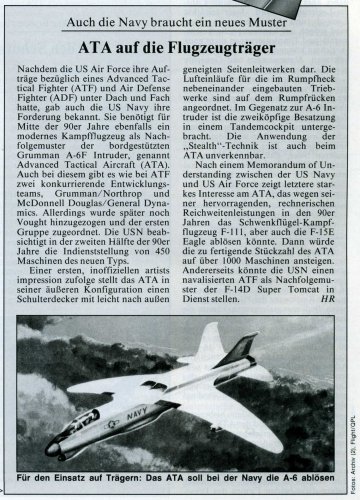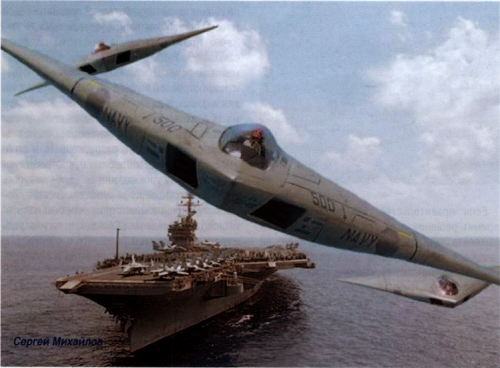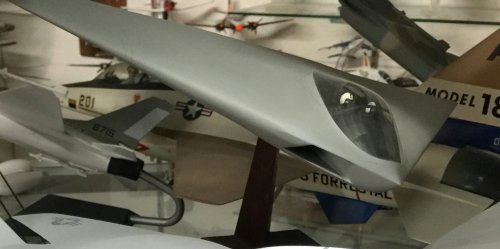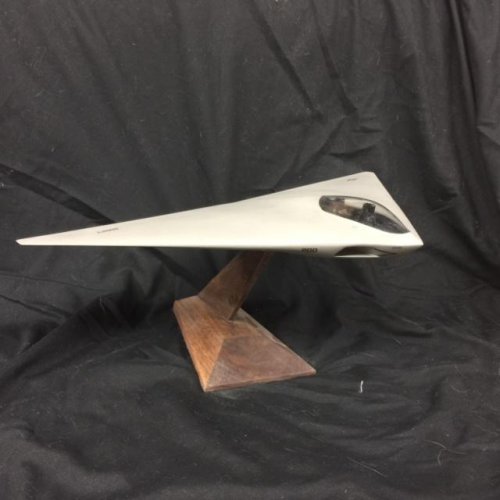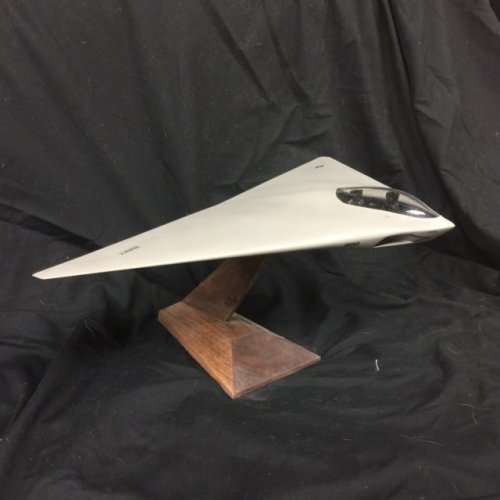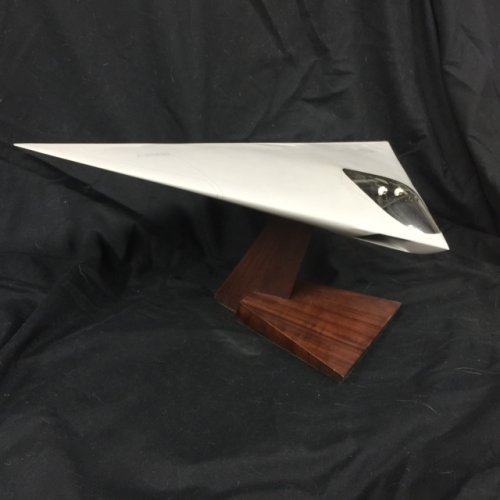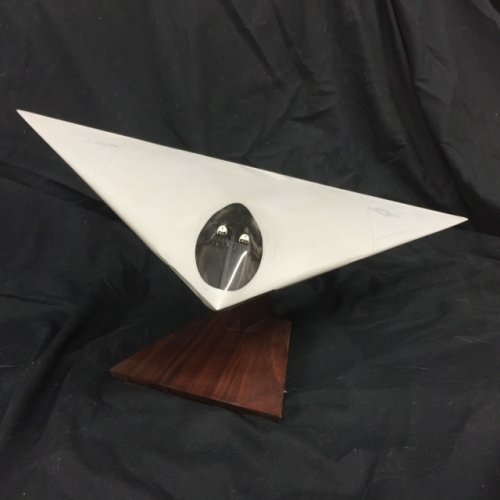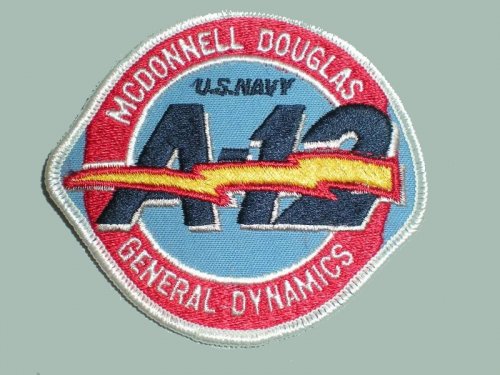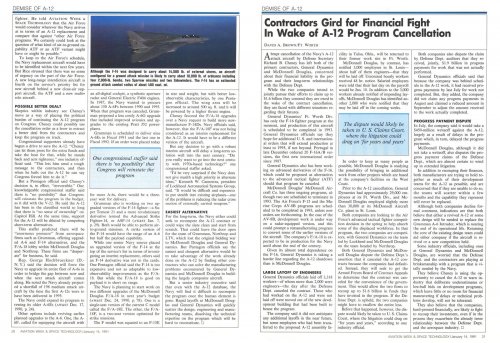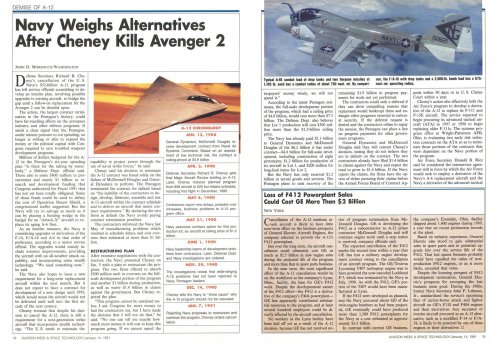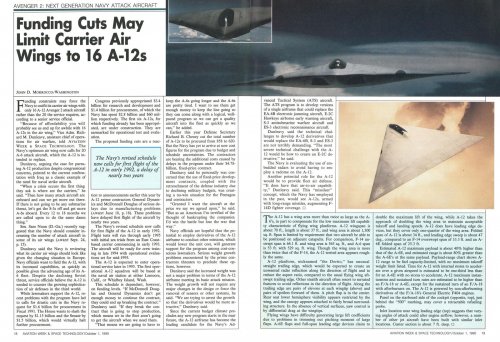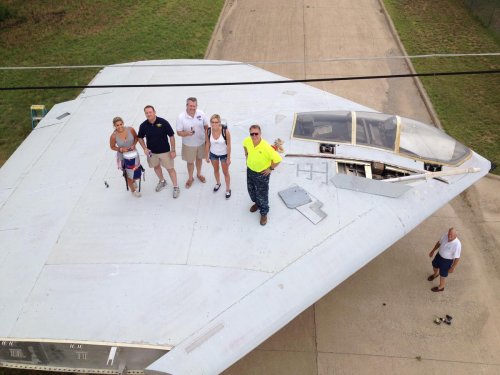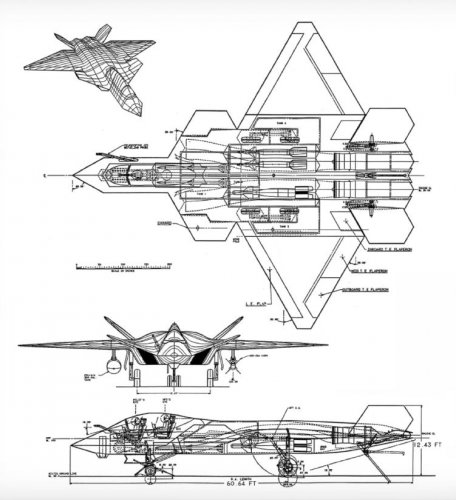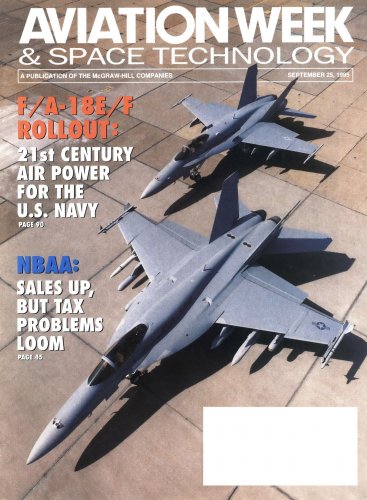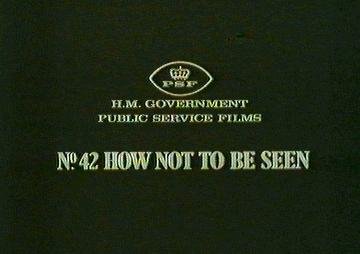You are using an out of date browser. It may not display this or other websites correctly.
You should upgrade or use an alternative browser.
You should upgrade or use an alternative browser.
US NAVY ATA (Advanced Tactical Aircraft) program: A-12 Avenger II & its rivals
- Thread starter overscan (PaulMM)
- Start date
- Joined
- 6 August 2007
- Messages
- 3,898
- Reaction score
- 5,997
LEG said:No. It is the aspect which counts because if you are LOS with an emitter, your aspect -change- is visible throughout the period of tangential or direct flyby.
Is dead wrong. If you have a shape which is only VLO across a narrow 30` cone off the nose (the A/FX was protected across almost 210`), turning your cruciform shape away from a given threat as a 'routing penalty' to thread the needle only opens up your vulnerable aspects to that radar and others.
Radar range is not static but aspect dependent. Turn away from your best (lowest db) protected aspect because you are pushing detection threshold and you guarantee your detection because you are IMPROVING the detection range which is variable on a whole 'nother set of parameters from that of WEZ kinematics.
So.... You're saying that frontal aspect low observables is not all aspect low observables.
...Got it.
LEG said:This is where the bodyguard of lies comes in. The propagandists WANT you to see a threat bubble as something which is a constant, like an aerodynamic envelope. But you have to see to shoot and the RCS does indeed vary, dramatically, with aspect. The only way to ensure you are fighting one radar alone is to sub-horizon the threat and take the others out of the LOS picture.
I can't say I've ever talked to a low observables engineer or mission planner who assumed that a radar's field of view, etc. was constant, or a static "bubble".I have seen threats represented as "bubbles" in trade publications and PR materials, but these are (obviously) simplifications.
I don't know what "propagandists" you are referring to. Can you cite some examples?
RCS varies with aspect (unless your object is a sphere), but an object can have very low RCS across a wide range of aspects. This is not propoganda or lies. This is science and engineering!
LEG said:No. It can isolate maximum return pathways along narrow azimuth lines but it can do very little to prevent backscatter in elevation. RAM is everything here and it is not enough against more than 1960s era systems of the early SA-2/3/5/6.
Uh, no. Really. Unless you can make your aircraft out of a magical material that has the electrical properties of free space, shaping always wins.
LEG said:It doesn't matter what the material is, if it's not creating an active electrical field, phase and wavelength tuned to impingent radar's -exact- operating frequencies, it is not going to do more than take 'a tenth off the top' of the impedance loading.
The reality is that modern RAM materials are quite effective, and when applied correctly are effective across multiple bands. They are not thick. They are not terribly heavy.
What you are trying to express (I assume) is this:
US4117485A - Radar target cross section control method and means - Google Patents
Radar target back scattering is controlled by an impedance loading technique. The target is loaded with a variable impedance that is adjusted in response to the frequency of any incident radar signal to achieve optimum reflectivity for that particular frequency. Either radar target cross section...
www.google.com
LEG said:And particularly against AESA with their large power loading, high PRF/PRI agility and wide bandwidth, it is simply not enough as the ground systems pay no operating band penalty for lower (2-4GHz and less) band systems anyway and these all have excellent penetration of the surface skinning of any 'fighter' jet, leaving too little back cavity space for the RAM to perform it's function.
No, that is not correct. 'Fighter' aircraft are constructed of either metal or composites. Metal is an excellent reflector. Composites are not (some are). The Windecker Eagle, which you cited previously as an example, was constructed of materials that made it 'transparent' to radar. Carbon fiber, graphite, etc. are also somewhat transparent to radar.
This is one of (several) reasons that many aircraft are coated with a bottom layer of conductive material, on top of which lies RAM. Radar does not penetrate this material, and it makes the RAM more effective (it serves other purposes as well). Some composite aircraft also have conductive elements buried in the structure.
So, uh, yeah. The RAM performs it's function fine.
LEG said:Where a Channel is milspeak for a reserved segment of operating bandwidth, 'Deep Channel RAM' is neither physical nor by better chemistry interacting with the signal. It can't. There isn't enough time as space to prevent the little metal bits behind from flaring back out as a return.
LEG said:Ahhhh, but the ZSR-62 was 'cancelled', everyone knows /thaaaat/. The easiest way to not talk about 'Stealth Jammers' is to deny they are on the airframe. No jammer suite = no active stealth.
Yes, the ZSR-62 was cancelled.
Can you point to a 'stealth jammer' on the B-2? Where are the antennas? How is it powered? What bay does it live in? How is it tested and maintained? Who built it? What qualifications are necessary to operate or maintain it?
LEG said:An internal Jammer that doesn't emit but interacts with the target emission at, or just under, the skin level.
OK.... it's a jammer that doesn't emit. So, what, it's just a black hole for the incoming energy? Please elaborate.
LEG said:WHO is providing the EOB mapping of these deep target areas in the middle of a nuclear war?
The DMS, the radar, and offboard national level systems. The B-2 was designed as an integrated part of the larger SIOP structure. Much of this is now public knowledge and documented on this forum and elsewhere.
LEG said:I would like to know why small plastic ribbons around the F-22/35 provide the same degree of protection as the fully planform aligned YF-23.
Huh? What leads you to believe these two things are equivalent? Both the F-22 and YF-23 use extensive shaping to reduce RCS.
LEG said:The B-2 has similar features in the surrounding frisbee curl on the wing LE.
It also has a _microwave oven_.
LEG said:It also has a deep enough body to support a secondary system, built into/under the skin.
If you have evidence to support that, please do post it (in an appropriate thread). A number of people have gone looking for such a system, and only found information that refutes the idea.
LEG said:I believe that, in fact, a similar approach is taken on the F-22 and F-35 and that whatever is not scattered on neutral bearings is deliberately dealt with as a surface wave by active cancellation.
Again, if you have information to support such an idea... post it in the appropriate thread.
LEG said:The Windecker Experiments shows the direct that stealth designers were thinkign _before_ Ufimtsyev. Dielectrics, not surface coatings. Skin penetration happens anyway and is one of the big reasons why fighter LO should be impractical on anything not a flying wing.
If you are familiar with the history of the Windecker Eagle, you would know that was not the case.
Also, as previously pointed out, dielectic materials were used in (more or less) the same way you are referring to on much older low observable aircraft such as the A-12 (OXCART).
LEG said:Oh, 'and by the way', the skin is naturally dielectric so if there is nothing buried in it or beneath it, the metallic components will be seen anyway.
Yes, they will. No material is completely 'transparent'. Except the magical material that has the electric properties of free space, of course.
Hence the huge and continuing investments on the ASQ-239.
LEG said:Doesn't change the spirit of what I said a bit. If the Skunk Works made the RCS model (for indeed it would have to be so if it was tested at RATSCAT) go from a 2 to a 9, it was most certainly stealthy, even if we are talking orders of magnitude incrementation between steps.
Finally we are getting back on topic.
The A-12 (Avenger II) was not stealthy by any modern measure.
A polar plot of the A-12 from the frontal aspect with parallel polarization looks like a big Y (with a unicorn hedgehog in the middle). That wouldn't be too bad if the ends of the Y had smaller values (they are large, but not A-6 large).
Now, with perpendicular polarization, the polar plot is the opposite - an upside down Y. A very significant amount of energy is scattered back at the emitter. And then with circular polarization, it's both! The polar plot looks like the two previous combined, forming an * shape.
This is less than ideal. No amount of RAM would have fixed the problems with the shape of the aircraft.
At the same time that the A-12 program was going, GD was also working on the ATF program. They initially pursued three different concepts, with the "low observable" concept based on the A-12 platform. When USAF made the observables requirements part of ATF, they were much lower than what GD was able to get from the A-12 derived efforts. They ended up going in a very different direction, partially because of the more aggressive LO requirements. An A-12 derived design could not meet the USAF LO requirements (or the other requirements, but anyway...).
The USAF program office for the A-12 also raised a red flag about the signature of the A-12. They did not think that the A-12 would meet the requirement set by the Navy, and this was based on an analysis of the design.
LEG said:Because, even though it's based on a physical vs. virtual measurement system an RCS pole model can never match the NUMBER OR INCIDENT ANGLE variations that a computer model can.
No, you can do that with a pole model. It's time consuming (and you need several models), but you can.
LEG said:Again, this can only be true if someone, somewhere, likely to preserve their own pet program (F-22, C-17, whatever) coughed on some very significant weight tradeable stealth technologies that took the A-12 from the Gen-1 era of the F-117's linoleum towards the 'best there was at the time' which would have been the B-2.
No, it means that the Navy observables spec was miguided to begin with, and that GD wasn't going to miss it by "much". Public statements about the USAF anaylsis of the A-12 confirm that. Reshaping the nose of the A-12 and fixing the inlets and canopy would address the dBsm shortfall in the frontal aspect, and would have the A-12 meet the original spec. The original spec, however, was not aggressive when compared to the USAF programs of the same time period. The Navy knew this after the fact from their involvement with SENIOR PENNANT.
LEG said:Your problem is that you are hiding behind detail rules and ignoring the main one which is that the data doesn't match the theory. This contradiction principle is a key element of logic as scientific reason and the F-22/F-35 are not what they seem if the shape-shape-shape-materials rule is true.
What theory? The laws of thermodynamics or the Lorentz force law? I assure you, the data does match. You can perform your own experiments that verify it.
LEG said:Again, if you ARE an EE doctoral (the level at which they start to explain how it really all works)
An introductory physics text book is where 'they start to explain how it really all works'.
Last edited by a moderator:
- Joined
- 18 June 2009
- Messages
- 1,412
- Reaction score
- 2,494
A-12 Side by Side Cockpit Nose Model on eBay ending at midnight CST:
Attachments
-
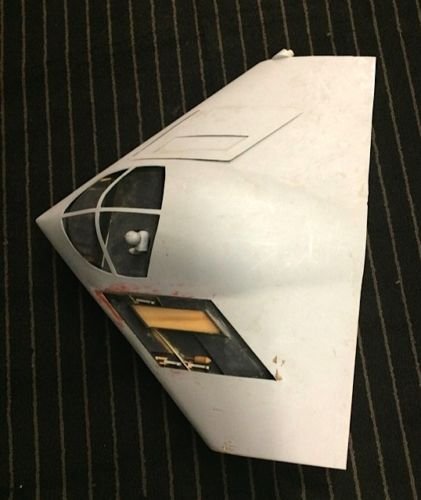 GD A-12 SBS Cockpit 01.JPG26.4 KB · Views: 1,186
GD A-12 SBS Cockpit 01.JPG26.4 KB · Views: 1,186 -
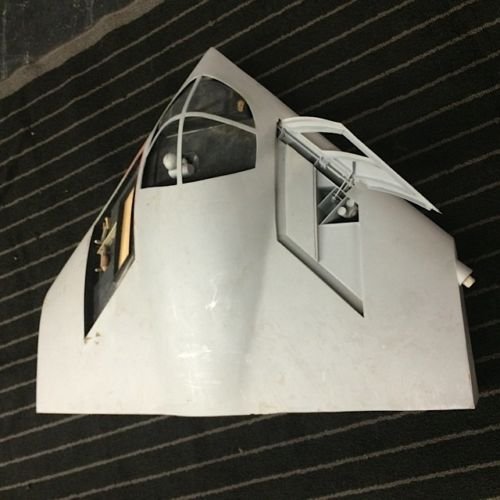 GD A-12 SBS Cockpit 08.jpg33.2 KB · Views: 279
GD A-12 SBS Cockpit 08.jpg33.2 KB · Views: 279 -
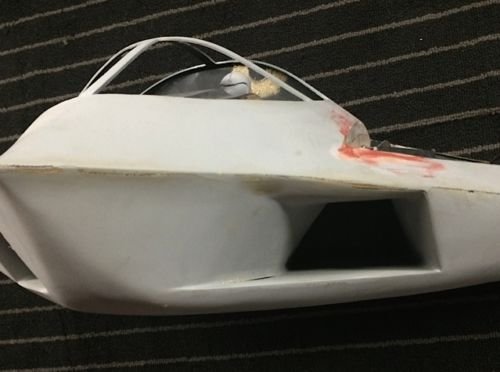 GD A-12 SBS Cockpit 07.jpg22.4 KB · Views: 219
GD A-12 SBS Cockpit 07.jpg22.4 KB · Views: 219 -
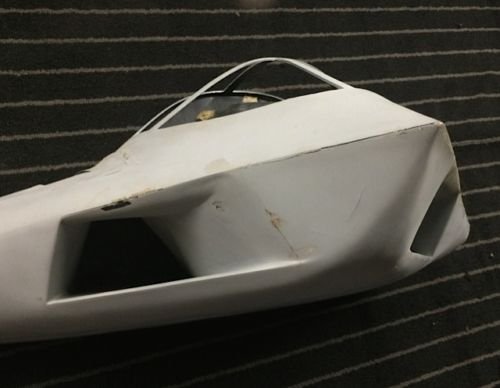 GD A-12 SBS Cockpit 06.jpg21.4 KB · Views: 191
GD A-12 SBS Cockpit 06.jpg21.4 KB · Views: 191 -
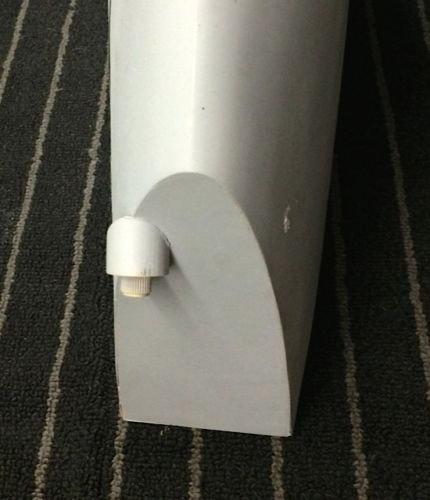 GD A-12 SBS Cockpit 05.jpg26.5 KB · Views: 215
GD A-12 SBS Cockpit 05.jpg26.5 KB · Views: 215 -
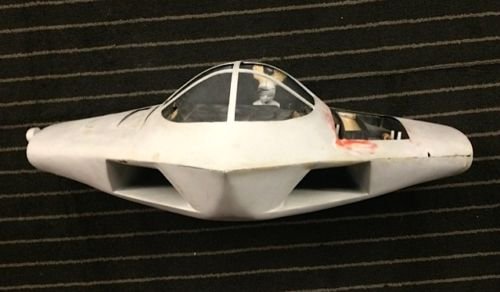 GD A-12 SBS Cockpit 04.jpg21.7 KB · Views: 1,045
GD A-12 SBS Cockpit 04.jpg21.7 KB · Views: 1,045 -
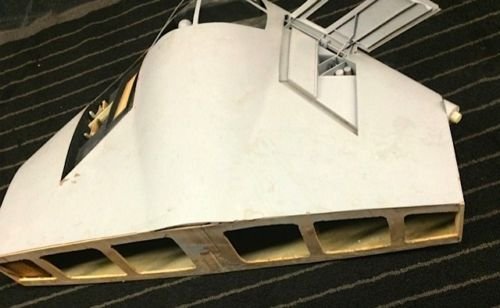 GD A-12 SBS Cockpit 03.jpg24.3 KB · Views: 1,069
GD A-12 SBS Cockpit 03.jpg24.3 KB · Views: 1,069 -
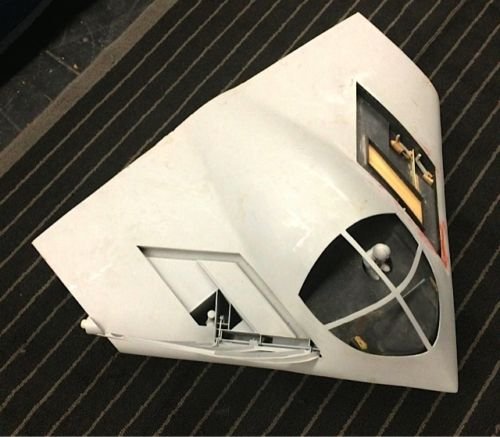 GD A-12 SBS Cockpit 02.jpg34.8 KB · Views: 1,183
GD A-12 SBS Cockpit 02.jpg34.8 KB · Views: 1,183
Last edited by a moderator:
XP67_Moonbat
ACCESS: Top Secret
- Joined
- 16 January 2008
- Messages
- 2,272
- Reaction score
- 544
- Joined
- 11 March 2011
- Messages
- 307
- Reaction score
- 1,196
OK... here ya go. Two in-house A-12 Avengers in different sitting configurations. Resin construction, but I have had a heavy plastic as well that was very light weight. The model shop seemed to have played with various materials as the project progressed. Enjoy.
Attachments
I
Ian33
Guest
What a beautiful aircraft.
Thank you for sharing.
Thank you for sharing.
XP67_Moonbat
ACCESS: Top Secret
- Joined
- 16 January 2008
- Messages
- 2,272
- Reaction score
- 544
Thank you!
Steve Pace
Aviation History Writer
- Joined
- 6 January 2013
- Messages
- 2,266
- Reaction score
- 225
I would love to hear A-12s in operation - they would be way quieter than A-6's. Have you ever heard the latter? Talk about noisy with their J52s. -SP
XP67_Moonbat
ACCESS: Top Secret
- Joined
- 16 January 2008
- Messages
- 2,272
- Reaction score
- 544
I remember the Prowlers being pretty loud, back when U served on the Truman.
- Joined
- 27 December 2005
- Messages
- 17,755
- Reaction score
- 26,468
Attachments
Last edited:
- Joined
- 27 December 2005
- Messages
- 17,755
- Reaction score
- 26,468
- Joined
- 24 November 2008
- Messages
- 1,550
- Reaction score
- 2,617
pedrospe has posted this small pic of a Northrop concept for the AX program to replace the cancelled A-12 in another thread:
http://www.secretprojects.co.uk/forum/index.php/topic,27301.msg296118.html#msg296118
Can someone identify?
EDIT: Exchanged it with a higher res pic that appears in "Flying Wings Radical Things Part 2" @43:25
https://www.youtube.com/watch?v=uUNLf9OfWDA
http://www.secretprojects.co.uk/forum/index.php/topic,27301.msg296118.html#msg296118
Can someone identify?
EDIT: Exchanged it with a higher res pic that appears in "Flying Wings Radical Things Part 2" @43:25
https://www.youtube.com/watch?v=uUNLf9OfWDA
Attachments
- Joined
- 24 November 2008
- Messages
- 1,550
- Reaction score
- 2,617
SOC said:That's one of three Northrop designs for the AX, the A-12 follow-on project that never materialized.
See EDIT of my post above. Tony Chong calls it the "performance driven configuration" proposed for NATF.
BR Michael
Here's a 'what if' question:
If the first A-12 prototype had been completed and rolled out, any speculation as to what the 'rollout' paint scheme might have been? I'm thinking overall light gray, but (thinking of F/A-18 prototype influences) perhaps with navy blue and gold trim. From other inquiries I've made, it appears there were never any painting diagrams completed for the prototype. This is for an A-12 model I'm currently building.
Any speculation welcome!
If the first A-12 prototype had been completed and rolled out, any speculation as to what the 'rollout' paint scheme might have been? I'm thinking overall light gray, but (thinking of F/A-18 prototype influences) perhaps with navy blue and gold trim. From other inquiries I've made, it appears there were never any painting diagrams completed for the prototype. This is for an A-12 model I'm currently building.
Any speculation welcome!
- Joined
- 1 April 2006
- Messages
- 11,401
- Reaction score
- 10,328
Think of F/A-18E roll-out scheme (September 1995), not F/A-18A one. That also fits to single-grey-tone camo of official desktop models and art.arg said:If the first A-12 prototype had been completed and rolled out, any speculation as to what the 'rollout' paint scheme might have been? I'm thinking overall light gray, but (thinking of F/A-18 prototype influences) perhaps with navy blue and gold trim.
Attachments
- Joined
- 21 May 2006
- Messages
- 3,003
- Reaction score
- 2,284
I'm thinking the roll-out of the 'production' A-12 might not have either been shrouded in secrecy, or as in the case of the Northrop B-2, staged so as to not give away it's visual 'stealth' characteristics?
Regards
Pioneer
Regards
Pioneer
- Joined
- 21 December 2006
- Messages
- 1,245
- Reaction score
- 1,107
Having read The $5 Billion Misunderstanding and this thread, I have a question. Does anyone know of a good book/article that weighs the pros and cons of stealth, how it has changed over time and how it relates to other aspects of combat aircraft design and operation? Preferably something with real examples rather than just abstract electro-magnetic theory and notional designs.
Stevenson says stealth is 'unscientific', but I don't really agree. It is certainly expensive. But it is hard to find an objective, semi-technical work that gives the pros and cons in a balanced way, and with some context. The best I have found is a 1989 Salamander book - is there anything better? I have the F-22/F-117 books by Piccirillo et al, Sweetman's works etc.
Stevenson says stealth is 'unscientific', but I don't really agree. It is certainly expensive. But it is hard to find an objective, semi-technical work that gives the pros and cons in a balanced way, and with some context. The best I have found is a 1989 Salamander book - is there anything better? I have the F-22/F-117 books by Piccirillo et al, Sweetman's works etc.
- Joined
- 29 July 2009
- Messages
- 1,771
- Reaction score
- 2,482
Harrier, here is a link to an excellent primer on aircraft stealth technology with historical examples of its tactical employment. And its free to download from Scribd.com.
The RADAR Game: Understanding Stealth and Aircraft Survivability
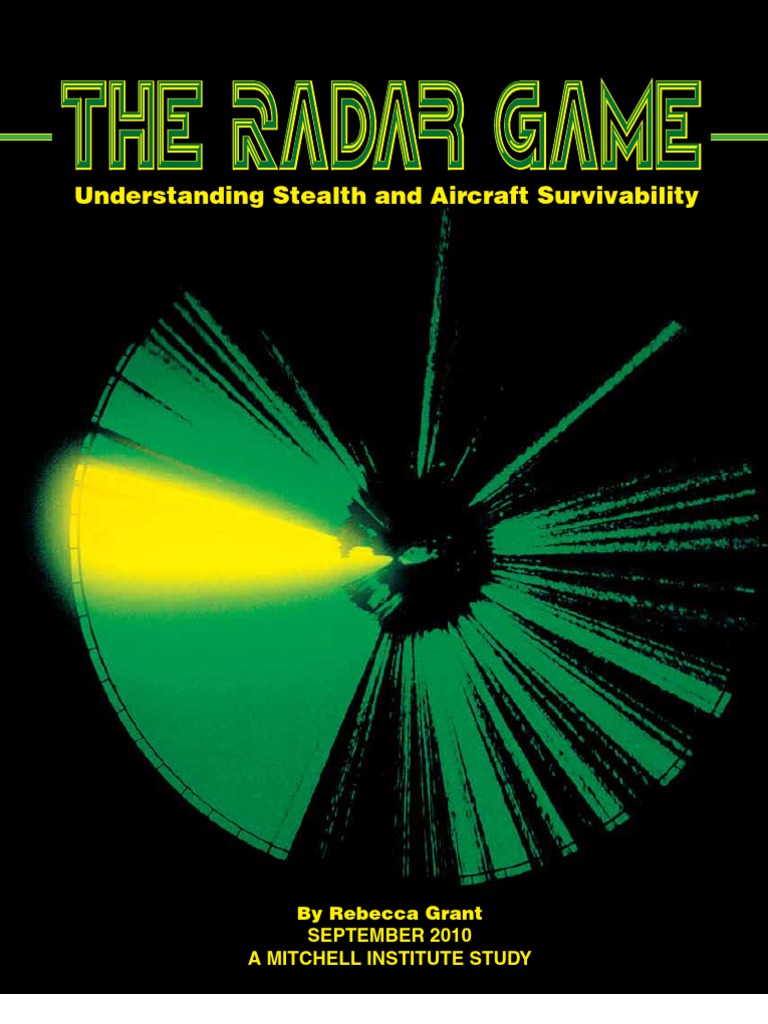
And on the opposite side of the issue: Counter Stealth Technology:
The RADAR Game: Understanding Stealth and Aircraft Survivability
And on the opposite side of the issue: Counter Stealth Technology:
- Joined
- 1 April 2006
- Messages
- 11,401
- Reaction score
- 10,328
Harrier said:Does anyone know of a good book/article that weighs the pros and cons of stealth, how it has changed over time and how it relates to other aspects of combat aircraft design and operation?
Preferably something with real examples rather than just abstract electro-magnetic theory and notional designs.
DrRansom
I really should change my personal text
- Joined
- 15 December 2012
- Messages
- 701
- Reaction score
- 302
A list of pros and cons for stealth aircraft it's complicated, because some of the cons are pretty unquantifiable, e.g. Cost of development vs a comparable non-stealth aircraft, lifetime costs including upgrades.
- Joined
- 3 June 2011
- Messages
- 18,348
- Reaction score
- 12,264
DrRansom said:A list of pros and cons for stealth aircraft it's complicated, because some of the cons are pretty unquantifiable, e.g. Cost of development vs a comparable non-stealth aircraft, lifetime costs including upgrades.
Add in resources too. One plane can carry out a mission by itself that would require dozens of non-stealth aircraft just to get the bomb to the target.
red admiral
ACCESS: Top Secret
- Joined
- 16 September 2006
- Messages
- 1,812
- Reaction score
- 2,392
Interesting question - pretty sure no one has pulled all that together into a single story. Sounds like a job for a historical researcher...
The main problem is that many of the issues are classified for obvious reasons, and its really complicated, and the answers will vary for different countries. There's a lot of probability statistics to do, and then wrap up at campaign level. Not to mention that the answers to some key questions aren't "known" and can only be estimated e.g. what is the effectiveness of jamming vs a specific threat system?
Now there's definitely material on design impacts and cost impacts - pm/email me if you want to discuss more. Cost impact isn't as much as you might think, especially if you've already made the investment in design skills, tools and knowledge.
The main problem is that many of the issues are classified for obvious reasons, and its really complicated, and the answers will vary for different countries. There's a lot of probability statistics to do, and then wrap up at campaign level. Not to mention that the answers to some key questions aren't "known" and can only be estimated e.g. what is the effectiveness of jamming vs a specific threat system?
Now there's definitely material on design impacts and cost impacts - pm/email me if you want to discuss more. Cost impact isn't as much as you might think, especially if you've already made the investment in design skills, tools and knowledge.
- Joined
- 21 May 2006
- Messages
- 3,003
- Reaction score
- 2,284
Harrier said:Having read The $5 Billion Misunderstanding
Must get my hands on this book!!
Regards
Pioneer
marauder2048
"I should really just relax"
- Joined
- 19 November 2013
- Messages
- 3,157
- Reaction score
- 926
Pioneer said:Harrier said:Having read The $5 Billion Misunderstanding
Must get my hands on this book!!
Regards
Pioneer
It's hopelessly dated.
- Joined
- 17 October 2006
- Messages
- 2,393
- Reaction score
- 1,198
The information is available in many places. However, it's a very complex picture. There is no single level of stealth, let alone a single "stealth" technology. It depends entirely on where you want to hide, low long and from what.
And it doesn't help that people get paid a ton of money to present one version of the story and that imbeciles parrot such rubbish. Here's one guideline: as soon as anyone talking about this subject opens a sentence with "Simply put..", lace up your waders!
And it doesn't help that people get paid a ton of money to present one version of the story and that imbeciles parrot such rubbish. Here's one guideline: as soon as anyone talking about this subject opens a sentence with "Simply put..", lace up your waders!
Attachments
- Joined
- 21 December 2006
- Messages
- 1,245
- Reaction score
- 1,107
Thanks to all for the replies and links. The material is good, and has helped clarify what I think I am after (and Red Admiral seems to suggest I write!): an overview of how stealth is used in overall design. It is often treated in isolation, but all the other aspects of aircraft design are subject to more integrated debate (do we go supersonic or have long endurance etc.).
Much of this involves trade-offs that are not directly comparable, and numbers that may be open to debate. I do wonder if the highly precise numerical nature of stealth makes this hard to do.
It would also be interesting to see how the trades may have varied over time, as more is learned and threats and benefits change. STOVL evolved, but never became as 'religious' as stealth. Of course, stealth planes spend 95% of their time in fixed locations....!
Much of this involves trade-offs that are not directly comparable, and numbers that may be open to debate. I do wonder if the highly precise numerical nature of stealth makes this hard to do.
It would also be interesting to see how the trades may have varied over time, as more is learned and threats and benefits change. STOVL evolved, but never became as 'religious' as stealth. Of course, stealth planes spend 95% of their time in fixed locations....!
DrRansom
I really should change my personal text
- Joined
- 15 December 2012
- Messages
- 701
- Reaction score
- 302
sferrin said:DrRansom said:A list of pros and cons for stealth aircraft it's complicated, because some of the cons are pretty unquantifiable, e.g. Cost of development vs a comparable non-stealth aircraft, lifetime costs including upgrades.
Add in resources too. One plane can carry out a mission by itself that would require dozens of non-stealth aircraft just to get the bomb to the target.
Quite, some missions would be basically impossible without stealth, such as reconnaissance / strike in hostile airspace in opening days of a war, other missions don't require stealth at all, such as bombing ISIS.
Though, stealth bombers still need support, just less of it.
The trade-offs are pretty complicated.
barbara_em
ACCESS: Restricted
- Joined
- 13 May 2017
- Messages
- 10
- Reaction score
- 35
Regarding the much mentioned book, The $5 Billion Misunderstanding, I'll not read it; that's simply not in the cards. However, I'm a curious cat of a gal. Perhaps some gentle members of the forum can tell me who was misunderstood and who did the misunderstanding? Did the contractors misunderstand what the navy wanted? Did the navy misunderstand what was feasible for the amount of money they wanted to spend? Was there willful obfuscation? Is there any culpability? Certainly the contractors suffered financially. Likewise, the military suffered since they didn't get a plane they obviously wanted (unless that desire was a sham; perish the cynical thought!) Did heads roll? I doubt it. Even back then, the country seemed to have a well entrenched idea that no one is ever culpable. Or if they are, there's no penalty or other consequences for one's guilt.
Personally, I think whatever the misunderstanding, $5 billion, even in trillion dollar budgets, buys a lot of cat food. My part of Texas just received many feet of water in a short period. It's not much water when compared with the volume of the Gulf of Mexico. For the area, it's a lot, though.
Personally, I think whatever the misunderstanding, $5 billion, even in trillion dollar budgets, buys a lot of cat food. My part of Texas just received many feet of water in a short period. It's not much water when compared with the volume of the Gulf of Mexico. For the area, it's a lot, though.
Not much water? It was 33 trillion gallons. It was so heavy it deflected the crust of the earth in Harris county by 2 centimeters. Why don't you drive through Meyerland where the contents of everyones home including the floors and walls are on the street. It looks like a war zone. BTW being too lazy to pick up a book is not going to win you many friends here.
sublight is back said:BTW being too lazy to pick up a book is not going to win you many friends here.
The claim wasn't being too lazy to read the book; the claim simply was that reading it wasn't in the cards. Last time I saw a copy of it on ebay it went for over $100, so, yeah, it's not in the cards for me, either.
That's how they getcha. 
https://www.amazon.com/Billion-Misunderstanding-Collapse-12-Stealth/dp/1557507775
The reviews provide insight into what the book covers. I've read it at least twice and wouldn't have been as positive in my assessment. The author is a lawyer want-to-be (he has a BA in Fine Arts and Biology) and, with the benefit of hindsight, heaps scorn on all involved, taking a very legalistic, one-sided view of the proceedings. In his opinion, what actions weren't felonious (his words) were incompetent. I think the title is a little misleading given his assessment. It was more like "The $5 Billion Waste of Money".
The reviews provide insight into what the book covers. I've read it at least twice and wouldn't have been as positive in my assessment. The author is a lawyer want-to-be (he has a BA in Fine Arts and Biology) and, with the benefit of hindsight, heaps scorn on all involved, taking a very legalistic, one-sided view of the proceedings. In his opinion, what actions weren't felonious (his words) were incompetent. I think the title is a little misleading given his assessment. It was more like "The $5 Billion Waste of Money".
Similar threads
-
Advanced Tactical Support Aircraft (ATSA) US Navy
- Started by dauby09
- Replies: 22
-
Northrop Grumman Supersonic Tailless Air Vehicle (STAV) concept
- Started by flateric
- Replies: 17
-
Convair / General Dynamics Advanced Tactical Fighter (1965)
- Started by overscan (PaulMM)
- Replies: 15
-
VSX / TS-160: Alternatives to the S-3 Viking
- Started by Pioneer
- Replies: 95
-
ADF to LWF: Evolution of the General Dynamics F-16
- Started by overscan (PaulMM)
- Replies: 136

